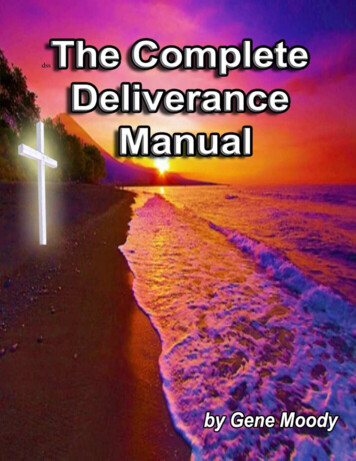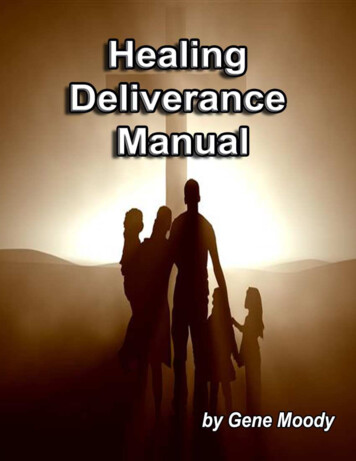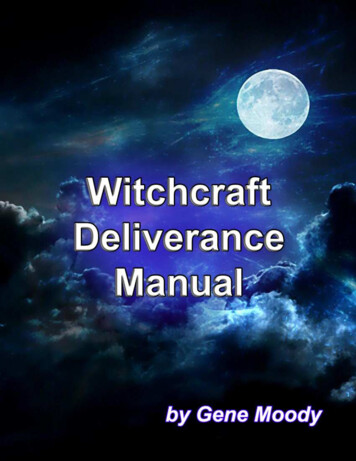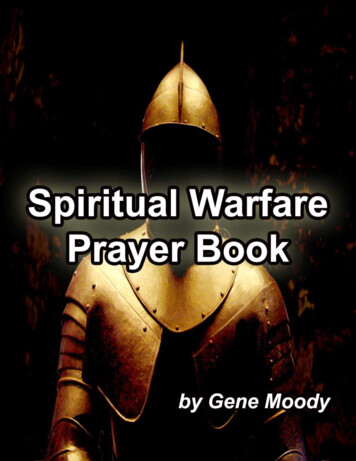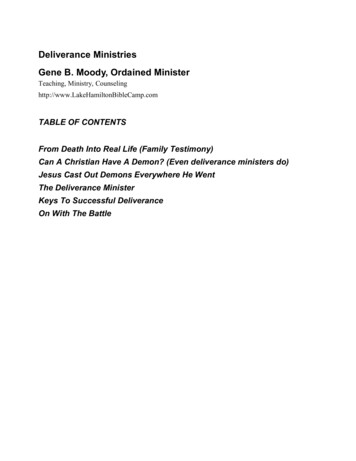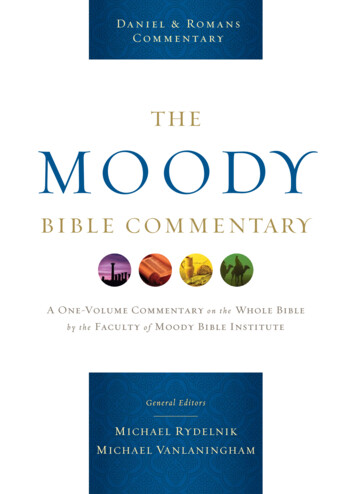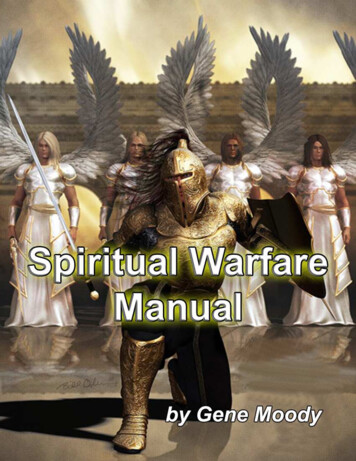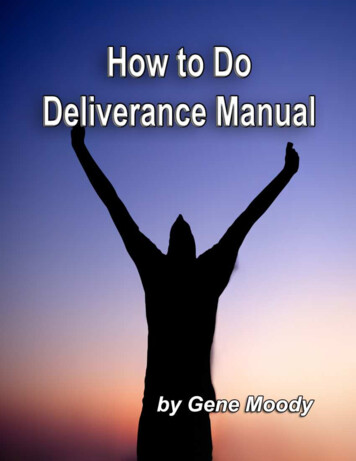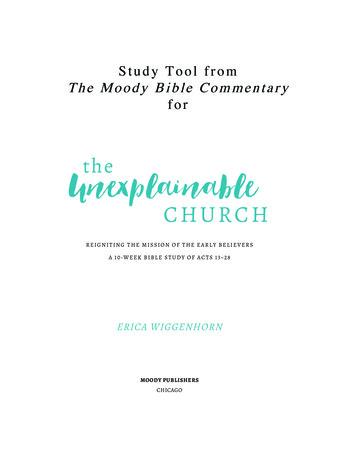
Transcription
Study Tool fromThe Moody Bible CommentaryfortheUnexplainableCHURCHREIGNITING THE MISSION OF THE EARLY BELIEVERSA 10-WEEK BIBLE STUDY OF ACTS 13–28ERICA WIGGENHORNMOODY PUBLISHERSCHICAGOUnexplainableChurch INT F.indd 34/12/17 2:24 PM
Excerpts are from The Moody Bible Commentary 2014 byThe Moody Bible Instituteof ChicagoAll rights reserved. No part of this book may be reproduced in any form without permission inwriting from the publisher, except in the case of brief quotations embodied in critical articles orreviews.All Scripture quotations, unless otherwise indicated, are taken from the New AmericanStandard Bible . Copyright 1960, 1962, 1963, 1968, 1971, 1972, 1973, 1975, 1977, 1995 by TheLockman Foundation. Used by permission. (www.Lockman.org)Scripture quotations marked ESV are taken from The Holy Bible, English Standard Version.Copyright 2000, 2001 by Crossway Bibles, a division of Good News Publishers. Used bypermission. All rights reserved.Scripture quotations marked NIV are taken from the Holy Bible, New International Version ,NIV . Copyright 1973, 1978, 1984, 2011 by Biblica, Inc. Used by permission. All rightsreserved worldwide. www.zondervan.comScripture quotations marked NLT are taken from the Holy Bible, New Living Translation.Copyright 1996, 2004, 2007 by Tyndale House Foundation. Used by permission of TyndaleHouse Publishers, Inc., Carol Stream, Illinois 60188. All rights reserved.Scripture quotations marked HCSB are taken from the Holman Christian Standard Bible .Copyright 1999, 2000, 2002, 2003 by Holman Bible Publishers. Used by permission. HolmanChristian Standard Bible , Holman CSB , and HCSB are federally registered trademarks ofHolman Bible Publishers.Managing Editor: Allan SholesEditors: Christopher Reese, Paul Brinkerhoff, Philip Rawley, Jim VincentInterior Design: The Livingstone CorporationCover Design: Smartt Guys designCover photo of ruins copyright by claranatoli/123RF/304462. All rights reserved.Cover photo of scroll copyright by James Steidl/123RF/7038329. All rights reserved.Cover photo of loaves & fish copyright by Photowitch/Dreamstime/12062355. All rightsreserved.Cover photo of camel riders copyright 2005 by zepperwing/iStock/1035697. All rightsreserved.Produced with the assistance of The Livingstone Corporation (www.LivingstoneCorp.com).ISBN: 978-0-8024-2867-7We hope you enjoy this book from Moody Publishers. Our goal is to provide high-quality, thought-provokingbooks and products that connect truth to your real needs and challenges. For more information on other booksand products written and produced from a biblical perspective, go to www.moodypublishers.com or write to:Moody Publishers820 N. LaSalle BoulevardChicago, IL 60610UnexplainableChurch INT F.indd 44/19/17 9:37 AM
Introduction“In order to understand the Bible, you must read it.” This is an axiom that we both firmly believe. A secondary principle to which we both hold is, “If you didn’t understand it the first time,read it again.” More than anything else, the understanding of the Bible requires reading it, andthen reading it some more. For many generations, committed believers held to the principleof the clarity of Scripture. Among other things, this simply means that if followers of Jesus theMessiah read the Bible, they can understand it. Nevertheless, there are some qualifications forthis general principle:1. Understanding the Bible requires effort—we need to work at studying the Scriptures. the Bible will take time—we won’t get it all immediately.2. Understanding3. Understanding the Bible requires that the Holy Spirit open our hearts and minds to theScriptures.4. Understanding the Bible will happen only if we are willing to obey it. the Bible will never be complete—we can always learn more.5. UnderstandingHaving said this, we all need some help from time to time to understand the Scriptures. A personmay be reading the Bible for his or her own personal time in the Word and run across a phraseor a word, and wonder, “What does that mean?” Or a Sunday school teacher or small group leadermight be preparing a Bible Study and wonder, “How does this passage fit with the paragraph thatwent before it?” Or pastors or teachers might encounter people confused by a particular verse andmight need some help clarifying its meaning. It is for these reasons, and many more, that all ofthe contributors for this resource have worked so hard to produce The Moody Bible Commentary.We want to help that reader, Sunday school teacher, home group leader or pastor have a betterunderstanding of the Bible. Of course, there are many good commentaries to which the Biblestudent could turn. What makes this commentary distinctive?The Moody Bible Commentary is trustworthy. For generations Moody Publishers has had theslogan, “The Name You Can Trust.” That derives from being the publishing house of the MoodyBible Institute, an institution that has maintained its commitment to the truth of the Word ofGod since 1886. Since the founding of Moody Bible Institute, there have been countless attackson the veracity of Scripture, innumerable attempts to undermine its teaching, and significantchallenges to its authority. Nevertheless, in all that time, the administrators and professors atMoody Bible Institute have maintained a commitment to the inerrancy and inspiration of theBible as the very Word of God. This high view of Scripture, along with a determination to practicefirst-rate biblical scholarship, has made Moody the name you can trust. Thirty faculty membersof the Moody Bible Institute have worked together to produce The Moody Bible Commentary withexplanations that are reliable.The Moody Bible Commentary is understandable. The authors and editors have striven to explainthe Scriptures in a simple and clear way. They defined theological terms, clarified the meaning ofdifficult biblical words, identified ancient sources with which readers might be unfamiliar, andgave the geographical locations of ancient biblical cities and towns. Although the writers engagedin excellent scholarly research, they made sure that readers would not need a commentary to helpthem understand this commentary.The Moody Bible Commentary shows the logic of biblical books. Too often people read theBible without regard for its literary context or structure. But the writers of Scripture, under thesuperintending work of the Holy Spirit, wrote inspired text with great literary artistry. Therefore,all biblical books have literary structure and strategies. One distinctive feature of this commentaryiMBC 00 Front 131217.indd 1919i12/17/13 8:27 AM
i20iINTRODUCTIONis that it follows the structures that are inherent in the biblical books themselves. The commentaryon each biblical book has an outline in its introduction. The body of the commentary followsthat same outline so a reader can follow the structure throughout that specific book. Moreover,the commentary itself traces the flow of thought, showing how each individual section fits inthe overall argument of the biblical book. In essence, The Moody Bible Commentary will providea road map through each book of the Bible.The Moody Bible Commentary deals with difficult verses. Sometimes the most frustratingaspect of using a commentary is that it complicates the explanation of difficult or disputedverses and fails to offer help precisely where it is most needed. The authors and editors workedhard to be alert to the possible difficulties in a text and its interpretation, and to address thoseissues clearly. Of course, every reader finds different questions and sees different difficulties.Nevertheless, this commentary hopes to answer the more perplexing questions. For example,does a particular Bible passage seem to contradict another? Not if it is the inspired Word of God.Also, readers of Scripture are often perplexed by biblical prophecies, wondering when and howthese were or will be fulfilled. When these apparent contradictions or perplexing difficultiespresent themselves, this commentary will address those issues. After all, if a commentary doesnot address the hard or unclear verses, then it really is not much help at all.The Moody Bible Commentary uses a literal interpretive method and applies it consistently. By“literal” we mean that the method that governs this commentary understands the words of thetext in a normal way. Unless there is a good reason to think otherwise, the phrases and expressions of Scripture are interpreted according to what appears to be their plain sense. If there is afigure of speech or symbol, then it is interpreted with sensitivity to that figurative expression.However, even in the case of figurative language, there is always some spiritual or physical realitythe biblical author is conveying through the figure of speech. For example, Jesus is not a literaldoor (see Jn 10:9), but this metaphor describes Him literally, as the only way for a person to entera forgiven relationship with God.Virtually all biblical interpreters agree with this “literal” approach. However, all do not applyit consistently, particularly in prophetic passages. A distinctive feature of this commentary is thatit understands much of prophecy in its literal sense and even prophetic symbols are recognizedas referring to a genuine reality. As a result, this approach to interpretation will affect how thecommentary understands Israel, the Church, and the end of days. In our view, this method ofinterpretation is the least subjective and easiest way to understand the Bible.The Moody Bible Commentary sees the Old Testament as a messianic text. The Lord Jesus taughtHis disciples about “all things which are written about Me in the Law of Moses and the Prophetsand the Psalms” (Lk 24:44). In commenting on this passage, A. T. Robertson once remarked, “Jesusfound himself in the Old Testament, a thing that some modern scholars do not seem to be able todo” (Word Pictures in the New Testament, vol. 2 [Nashville: Broadman, 1930], 294). Even thoughmuch of contemporary scholarship does not believe in direct predictive Old Testament propheciesof the Messiah, this commentary does. It presumes that God could and did reveal the messianichope to the writers of the Hebrew Bible. Moreover, it consistently shows how these propheciesmake sense in their literary context, pointing to the coming of the future Redeemer. Additionally,this commentary shows how the New Testament refers to Jesus of Nazareth as the fulfillment ofthese predictions, identifying Him as the Messiah of Israel and the Savior of the world.The Moody Bible Commentary is based on the original languages of Scripture. The commentaryuses the New American Standard Bible as its English language Bible text. When you see quotationsfrom the biblical text in the commentary, they are in bold and taken from the NASB. We chosethis translation for the commentary because it is, at the same time, among the more literal andreadable translations of the Bible available. However, the commentary authors did not rely on thetranslation of the NASB. Rather, in their research and study, they used the Hebrew, Aramaic, andGreek texts of the Bible. As a result, there are places where a commentary might point out a morefavorable translation of a word or phrase. The authors explain why this particular translation ispreferred and often show how a different English version may understand it in the same way or,if necessary, include their own translations of that phrase or word. As a result, this commentaryprovides a fresh exposition of the biblical text based on the original languages of Scripture.MBC 00 Front 131217.indd 2012/19/14 9:02 AM
I ntrod u C tioni21iThe Moody Bible Commentary is user-friendly. A variety of elements make this commentaryeasy to use. Besides using understandable language, it is a one-volume commentary. By limitingit to just one volume, the commentary can be the one book on your shelf to which you canturn when you need help understanding the Bible. Of course there are times when readerswill want to study a particular passage in greater detail. Therefore, the contributors includedin-text citations, directing readers to works they can use for deeper study. Also, for those whowould like greater depth in their study, there is a list of recommended works at the end of eachindividual commentary. Other helpful elements include an introduction to each book of theBible, dealing with key features, such as author, date, recipients, historical setting, theologicalissues, place in the canon, and an outline. There are also maps of the Bible lands as they relateto the Scriptures and helpful charts that clarify the biblical text.Other aids are included to help with your own personal study and deeper application. Ofcourse, there are subject and Scripture indexes to help readers locate or return to key themes andissues as needed. At various points throughout, there are cross references to key Bible passagesthat discuss related issues (typically shown with cf. and the Bible verses). Also included are notesdirecting the reader to other parts of the commentary for further discussion of the same issue ifit is discussed elsewhere. In addition, each chapter in the commentary includes some points ofapplication for today’s reader, reflecting the Scripture’s teaching that it remains a light to guide ourpaths (Ps 119:105) and is useful in daily life “for teaching, for reproof, for correction, for trainingin righteousness” (2Tm 3:16). Overall, this commentary wants to give you an accessible resourcethat will readily open the Bible for you, making simple what some might think is overly complex.Most of all, we want to encourage you never to substitute reading this commentary for actuallyreading the Bible. All of us, editors and contributors alike, want to support your reading of theBible by helping you understand it. But it is the actual reading of the Bible that will transformour lives. We concur with the wisdom of Proverbs: “He who gives attention to the word will findgood, and blessed is he who trusts in the Lord” (Pr 16:20).Michael A. RydelnikMichael G. VanlaninghamGeneral Editors MBC 00 Front 131217.indd 2112/17/13 8:27 AM
ACT S 1 3were amazed. After explaining how the Lorddelivered him, Peter told them to inform James(the brother of the Lord) about his release, andleft Jerusalem. Either sometime previously orat this point, James had become the leader ofthe Jerusalem assembly. Peter, who had functioned in this role at the birth of the church,recognized James’ leadership here. This foreshadowed the role James would play as leaderof the Jerusalem council where Peter merelyserved as a witness (Ac 15).12:17-19. The escape was a mystery to theguards. Herod questioned them and orderedthem led away for execution. Guards were heldaccountable for the security of prisoners, andsometimes would commit suicide to avoid execution if a prisoner escaped (See 16:27, thePhilippian jailer).b. Through Retribution: Herod Agrippa IWas Struck Dead (12:20-25)12:20-23. In contrast to Peter’s dramaticrelease, Luke described Herod’s disastrousend. The historical situation is described wellby Bock (Acts, 430): “Herod is caught in a dispute with Tyre and Sidon over the provision offood. These two Phoenician cities need foodand commerce from the region and have engaged in trade over a long period . . . Herodcan control where the commerce goes, and so,if he uses another port, such as Berytus (Beirut) or Caesarea, it could hurt Tyre and Sidonfinancially and possibly in terms of provisionas well.” Apparently Herod became infuriatedwith the cities, and representatives from themcame to Herod at Caesarea to fix things. Once anaccord was reached, perhaps in connection withHerod’s celebration of Caesar Claudius’s birthday, Herod sought to celebrate with a speech, thereactions to which both Luke and Josephus (Ant.19.8.2 [lines 343-350]) attested. Those reactionsincluded the people praising him as a god. Thistype of flattery was often heaped on rulers anddignitaries among the Gentiles; the Jews, however, reserved this honor for God. But Heroddid not refuse their praise. In fact he seemed todelight in it. The Lord ordered an angel to judgehim, and he died from some kind of painful andhorrible intestinal disease (eaten by worms).Died is literally “breathed his last” (cf. 5:5), andwas used for divine judgment.12:24. Though Herod attempted to eliminatethe church’s leaders, in the end, he was eliminated. His death made it possible for the Wordof God to continue its advance.MBC 44 Acts 131216.indd 1699i1699iGod’s sovereignty is a mystery. James wasexecuted, but Peter was miraculously released.Why God did not intervene to rescue James isa mystery that defies finite understanding. Themystery continues today. We still do not understand why God delivers some believers fromdanger and even death, but not others. Christians who suffer and die, sometimes as martyrs,are not notorious sinners. They are godly andlove the Lord, yet the Lord allows the enemies ofChristianity to persecute them. In many placesin the world today, Christians suffer and die fortheir faith. Stott, however, has reminded us thatthe victory of tyrants is temporary. He said, “Tyrants may be permitted for a time to boast andbluster, oppressing the church and hinderingthe spread of the gospel but they will not last.In the end their empire will be broken and theirpower abased” (Acts, 213).We do not know what would have happenedto Peter if the church had not prayed. We arenot even certain that they were praying for hisrelease, since they seem to have been embarrassingly surprised when he suddenly appeared atthe house where they were meeting. Like God’ssovereignty, prayer is also somewhat of a mystery. Scripture makes it clear that we ought topray and that prayer does make a difference.God answers prayer. But contrary to what somebelieve and teach, we do not need to have a gigantic measure of faith, only enough to believethat God will hear us and answer according toHis sovereign and unalterable purposes.In 12:25–13:3, the church at Antioch fulfilledJesus’ mandate to take the gospel to the world bycommissioning two Jewish men, Paul and Barnabas, as the first missionaries to the Gentiles.12:25. Luke continued the narrative from11:30. Barnabas and Saul returned to Antiochafter delivering aid to the church in Jerusalem.They brought Barnabas’ cousin, John Mark, withthem. This introduction of John Mark to thenarrative prepares the reader for the role hewould play on the first journey.C. To Asia Minor: The First MissionaryJourney (13:1–15:35)1. The Circuit of Proclamation (13:1–14:28)a. The Commissioning of Saul andBarnabas (13:1-3)The elimination of Herod’s threat freed thechurch for its first missionary endeavor. Thereason the first Gentile mission began in Antioch and not Jerusalem had nothing to do withanti-Gentile bigotry in Jerusalem. Initially, the1/31/17 8:22 AM
i1700iACT S 1 3gospel spread from Jerusalem to Antioch, so itwas Hellenistic Jews who intentionally reachedout to other Hellenistic Jews of Antioch (Ac11:19). The Antiochene church was initially composed of Hellenistic Jews (Ac 11:20-21). Additionally, the Jerusalem church heard of the ministryin Antioch, sent Barnabas to investigate, andgranted their approval of the church at Antiochthrough Barnabas (Ac 11:22-24). Ultimately,the primary teachers at Antioch were Saul andBarnabas, both Jews (Ac 11:25-26). The reasonthe mission began in Antioch was that at thispoint Saul was ministering in Antioch and hewas God’s chosen vessel to be the apostle to theuncircumcised. Therefore, God sovereignly directed the Antiochene church to send these twoJewish men, Saul and Barnabas, to reach theGentiles. Under the direction of the Holy Spirit,Paul’s First Missionary JourneyTIlysAS I ACaesarea(Mazaca)LystraDerbeHYLIASeleucia TracheotisJohn Mark separatesfrom Paul and Barnabasand returns to JerusalemIssusSyrianGatesAntiochSeleucia PieriaER.LYC I AC I AL II lomeliumLYCAONIAIconiumDAGCRYGIASULTANs R.CestruAttaliaAleppoSalamisS YRI ACYPRUSPaphos050100100MBC 44 Acts 131216.indd 1700150150 Miles200 KilometersABENIEDamascusJerusalemJo rda n R .EAAT50ENNAB0ILPHOCaesareaEACityMountain peakMountain passLYCIA Roman provincial nameFirst Missionary Journey:Paul and BarnabasCIAMEDITERRANEANSEAJUDAdapted from The New Moody Atlas of the Bible. Copyright 2009 The Moody Bible Institute of Chicago.R.LakeTuzAntioch in PisidiaLaodiceaC A P P A D O C I AHaCotiaeumAGordionGALADorylaeum1/31/17 8:22 AM
ACT S 1 3the church commissioned the missionaries, andthey sailed for Cyprus, the homeland of Barnabas. When they set out for Galatia, Mark leftthe team and returned to Jerusalem. Paul andBarnabas made a circuit in Galatia preachingthe gospel in four strategic cities—Antioch inPisidia, Iconium, Lystra, and Derbe. On their return to Antioch, they reported how God openedthe door of faith to the Gentiles.13:1. The presence of both prophets andteachers is evidence God had blessed the churchat Antioch with gifted men. The text here doesnot suggest a distinction in the ministry ofprophets and teachers, but generally in theNT, prophets carry on an itinerant ministryand the teachers instruct believers in the localchurch. For other features related to those whowere prophets, see the comments introducing1Co 14.The names of the men listed show the universal impact of the gospel. Barnabas was Jewishand from Cyprus; Lucius was from Cyrene inNorth Africa; Simeon (Niger) was Jewish witha Roman name; Manaen was a member of theupper class with connections to Herod; and Saulwas a Jew from Tarsus, who trained under thegreat Rabbi Gamaliel (regarding whom, see thecomments on 5:33-39).13:2-3. The commissioning of the missionaries took place while the church was worshipingand fasting. The Holy Spirit gave divine authorization for the first missionary journey by directing the church to set apart (dedicate) Barnabasand Saul for the first missionary journey.The church recognized the divine commission of Barnabas and Saul by the “laying on ofhands” (for which, see the comments on 6:5-6).After more fasting and prayer, the men were sentout under the authority of the church.The description of the commissioning of themissionaries suggests a twofold responsibilityfor the church—worship and mission. Both areessential. The church should meet to worshipand also to witness to the world.b. The Journey by Saul (Paul) and Barnabas(13:4–14:28)(1) Antioch to Seleucia to Salamis on Cyprus(13:4-12)(a) The Opposition by Elymas (13:4-8)In 13:4–14:28, Luke presented the circuit themissionaries travelled, starting with Paphos in13:4-12.13:4-5. The missionary team went first to Cyprus, the home of Barnabas (cf. Ac 4:36). TheyMBC 44 Acts 131216.indd 1701i1701ibegan their ministry in Salamis on the east ofthe island in synagogues, which were logicalplaces for explaining how Jesus fulfilled OTmessianic promises.13:6-8. From Salamis, they traveled about 90miles west to Paphos, the capital of Cyprus. AtPaphos they encountered Bar-Jesus who was described as a Jewish magician and false prophet.His name meant “son of Jesus,” which is ironicbecause he opposed the servants of Jesus. It isalso ironical that Sergius Paulus, who was a Gentile and proconsul (governor), summoned Barnabas and Paul so he could hear the Word of Godfrom them (which is probably why Luke labeledhim as a man of intelligence, v. 7), but Elymas(the Gk. name for Bar-Jesus) tried to keep Sergius Paulus from coming to faith. Elymas, whowas the personal magician of the proconsul,realized that if Sergius Paulus trusted Christ,he would be unemployed.(b) The Blinding of Elymas (13:9-12)13:9-11. Luke noted Saul’s name change. Nowthat he was ministering in a Gentile culturalcontext, Saul assumed his Greek name, “Paul.”It is also significant that Paul was filled with theHoly Spirit, an indication that his ministry wasdivinely approved and inspired.Paul announced judgmental blindness onElymas, who was full of deceit and treachery.He was a son of the devil, an enemy of all righteousness, and attempted to pervert the truth.Paul announced temporary, not permanent,judicial blindness on Elymas.13:12. In contrast to the blinding of Elymas,a Jew, Sergius Paulus, a Gentile, came to faithnot because of the judgment on Elymas but because of the teaching of the Lord. The blindingof Elymas and the conversion of Sergius Paulus demonstrated the beginnings of the changethat would happen in the early church—Israelwould more and more reject the gospel, whileGentiles would be increasingly receptive. Paulnoted later in Rm 11 that the Jewish people werehardened by God to allow time for the gospel tobe taken to the Gentile world, and the Gentileswould be the ones more inclined initially to embrace Messiah Jesus (cf. the comments on Rm11:11-24). Paul’s experience here at Paphos foreshadowed what he would experience throughout his life in ministry to Jews and Gentiles. Hisgospel message would largely be rejected by Jewsbut accepted by Gentiles. From a theologicalperspective this event provided the historicalbackground for Paul’s discussion of Jewish1/31/17 8:22 AM
i1702iACT S 1 3unbelief in Rm 9–11. There Paul answered thequestion about Gentile responsiveness to thegospel and Jewish unbelief. Did it mean thatGod’s plan of redemption for the Jewish peoplehad failed? The answer is an emphatic, “No!”Rather, Paul explained, Jewish unbelief openedthe door of faith to the Gentiles. Nevertheless,the temporary blinding of Elymas cannot becited to support the teaching that the churchhas replaced Israel in God’s program. See thecomments on Rm 11:25-32.This act of judgment was similar to Peter’sannouncement of judgment on Simon Magus(Ac 8), a comparison that functions to confirmthe legitimacy of Paul’s apostleship. Like Peter,who was one of the Twelve and an apostle to theJews, Paul had the same apostolic authority asan apostle to the Gentiles.(2) Paphos to Perga in Pamphylia (13:13)13:13. When they arrived at the port townof Perga, John Mark returned to Jerusalem (cf.11:30). Numerous reasons have been suggestedfor Mark’s returning to Jerusalem. Most likelyhe was overwhelmed with the rigors of theministry this missionary team was involvedin, rather than that some fundamental doctrinal rift developed between John Mark and hisveteran colleagues.(3) Perga to Pisidian Antioch (13:14-50)(a) Paul’s Message in Antioch (13:14-41)13:14-15. At Antioch, Paul established a pattern for ministry by preaching first to Jews andthen to Gentiles. Paul followed this strategy inevery city with a sizeable Jewish population. InPhilippi, according to 16:13, it seems Paul wasseeking a “place of prayer,” probably for Jewishpeople. So even in Philippi he sought out Jewishpeople first.After reading from the Law and the Prophets, the elders of the synagogue asked Paul andBarnabas to speak. It was customary to readfrom two sections of the OT—the Law and theProphets, and then give an interpretation. Theelders apparently considered Paul and Barnabasqualified to explain the Scriptures, so althoughthey were visitors, they were asked to speak. Paulseized the opportunity to explain how the promises of God to Israel were fulfilled in Christ.Paul’s message spanned the historical preparations God had made to prepare the Jewishpeople for the coming of their Messiah (13:1622), and what actually transpired when Jesusarrived (13:23-37). Paul concluded this review of the historical facts related to Jesus byMBC 44 Acts 131216.indd 1702challenging his listeners to trust in Jesus for theforgiveness of sins (13:38-41).13:16. He addressed both Jews and God-fearers, Gentiles who believed in God but were notconverts to Judaism. The primary theme wassuggested in 13:39: justification by faith, not bykeeping the Law of Moses.13:17-41. In his message, Paul gave a brief survey of Israel’s history from the exodus (Moses) tothe united kingdom (David). His main purposein 13:17-23 was to connect Christ to David: Fromthe descendants of this man, according to thepromise, God has brought to Israel a Savior,Jesus (13:23). When David desired to build ahouse for God, Nathan the prophet promisedDavid an eternal dynasty (see the commentson 2Sm 7:6-16 for the Davidic covenant). Paulidentified Jesus as the promised seed of David.Paul leaped from David to John the Baptist in13:24-25. His main point here was to emphasizethat John was not the Messiah, but that his mission was to prepare the nation for the comingof the Messiah. John was regarded favorablyby most of the Jewish people, and his purposehere may have been to connect Jesus with theBaptist in an attempt to incline the listenersfavorably to Him.In 13:26-30, Paul said that though the Scriptures were read in the synagogues, Israel’sleadership did not understand the message ofthe prophets and they condemned the Saviorthough He was innocent. In contrast to howthe Jewish leaders and Pilate condemned andconspired to kill Jesus, God raised Him fromthe dead, and His followers were witnesses ofHis resurrection.In 13:31-37 Paul appealed to three OT texts toprove Christ’s resurrection. Psalm 2 is a royalPsalm, and v. 7 makes an intimate connectionbetween the Messiah and God. He is God’s Son.Paul alluded to Is 55:3 in v. 34, and he informedhis audience that the promises made to Davidhad been given to them through Jesus who hadbeen raised from the dead. As did Peter in hisspeech in Ac 2, Paul quoted Ps 16:10, and insistedthat David could not have been speaking of himself since his tomb was in Jerusalem. Paul’s appeal to these texts was not arbitrary. First, as apostexilic collection, the Psalms in general, andthe royal Psalms in particular, pointed forwardto the future royal son of David, the Messiah.Thus, just as Paul explained, in Ps 2 God was notaddressing David, but rather called the MessiahHis Son. In the same way, Ps 16:10 predicts that1/31/17 8:22 AM
ACT
the commentary itself traces the flow of thought, showing how each individual section fits in the overall argument of the biblical book . In essence, The Moody Bible Commentary will provide a road map through each book of the Bible . The Moody Bible Commentary deals with difficult verses. Sometimes the most frustrating

